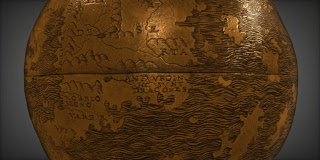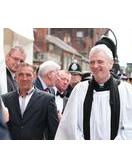Dragons are scary.
For the ancients, dragons represented the unknown, the monstrous, the terrifying.
They were fire-breathing serpents, with an obsession for treasure and a penchant for princesses.
I think of Smaug in the Hobbit, your archetypal dragon: living deep in his mountain, in caves scattered with the bones of cattle and humans, never fully asleep, guarding his treasure, virtually indestructible, cunning and deceptive, and when stirred or hungry or simply in a lousy mood, rousing himself to raid the haunts of men for food or treasure, and bringing devastation with his fire.
Dragons have come to represent in the ancient imagination, all that is scary, all that is beyond our control, all that is fearful, all that brings death and destruction. They are, in the ancient world’s imagination, the ultimate killing machine.
We find dragons in the Bible: a few more in the C17th KJV than in more contemporary versions! Today the word that is translated as ‘dragon’ in the KJV is (probably more correctly, but with far less imagination) translated as monster or even jackal.
So today – and I don’t normally do this – I am going with the KJV
Dragons are terrifying:
Jeremiah speaks of how Israel has been swallowed by King Nebuchadnezzar: ‘He hath swallowed me up like a dragon, he hath filled his belly with my delicates, he hath cast me out’. (Jeremiah 51:34)
Ezekiel speaks of Pharoah as ‘the great dragon that sprawleth in the midst of his rivers, which have said, My river is mine own, and I have made it for myself’ (Ezekiel 29:3)
Dragons live on the edge:
The Hunt Lenox globe of 1510 has those famous words written on the borderlands: ‘hic sunt dracones’, ‘here be dragons’.

Dragons live in the wilderness, in the deserted, desolate places:
Isaiah, speaking of the future judgment coming on Jerusalem, says, “And thorns shall come up in her palaces, nettles and brambles in the fortresses there of; and it shall be an habitation of dragons and a court of owls” (Isaiah 34:13 cf Jeremiah 9:11)
And Malachi, speaking of Edom, (Malachi 1:3), “And I hated Esau, and made his mountains and his heritage waste for the dragons of the wilderness”.
Or the lament of the Psalmist in Psalm 44, “Thou has sore broken us in the place of dragons and covered us with the shadow of death”.
Dragons also are lost:
Micah foreseeing the judgment that is coming on Israel declares (Micah 1:8), “Therefore I will wail and howl, I will go stripped and naked: I will make a wailing like the dragons, and mourning as the owls.”
So is it that surprising that in Revelation, Satan is described as the dragon (Greek: ‘Ho Drakon’)?
Satan is the reality behind all our fears of being overwhelmed, of destruction, of isolation and of despair. Satan is the father of lies and the master of fear.
And the ancients could find no better way of describing Satan than of describing not just as any old dragon, but as ‘The Dragon’:
Revelation 21:9, “And the great dragon was cast out, that old serpent, called the devil, and satan, which deceiveth the whole world”
Dragons can be defeated
There are remarkable parallels between the story of St Margaret of Antioch and St George.
Both of them lived in the time of Diocletian, the great persecutor of the church.
St George was a Christian soldier who was sentenced to death for refusing to renounce his Christian faith.
St Margaret was a 15-year-old girl who was tortured and executed because she refused to renounce her Christian faith.
And both their legends have them fighting with dragons and overcoming them.
George pierces the dragon with his spear and rescues the princess.
And the cross that Margaret holds tickles the dragon’s throat and forces him to expel her.
Both George and Margaret are executed and yet both are shown defeating the dragon.
How can that be?
How can we say that Margaret defeated the dragon and yet was executed?
If this world is all that we hope for, then it seems to me to be game, set and match to the dragon, to sin and to death.
But the victory of Margaret and of George is not the sort of victory that this world looks for.
This is the victory of the cross – it is the victory of Jesus Christ, who resisted all that the great serpent, the devil, threw at him to prevent him from going to the cross – the lies and violence, the hatred and the fear. It is the victory of love over fear, of forgiveness over condemnation, of goodness over evil.
And because of the resurrection of Jesus Christ, it is the victory of life over death.
There were two things which gave Margaret the conviction to persevere to the end, to give her life for her faith in Jesus Christ:
Her hope in the cross of Jesus, of his victory over sin and death, and that there is no situation from which God cannot bring resurrection
And the presence of the living Lord Jesus with her.
So the promise of Revelation 2:10 speaks of her and of countless others: “Fear none of those things which thou shalt suffer: behold, the devil shall cast some of you into prison, that ye may be tried; and ye shall have tribulation ten days: be thou faithful unto death, and I will give thee a crown of life.”
Even dragons can be converted
Polly Ionides, the artist who designed the gate, speaks of how she was influenced by Gaudi’s representation of the dragon: how dragon as enemy becomes dragon as friend.
Because of the victory of the cross, everything which is lost, everything which stands opposed to God may – if it so chooses - one day, in the new creation, join in with the praise of God.
There is nothing and no one beyond the possible redemption of God – not even dragons.
"Remember ye not the former things,
neither consider the things of old.
Behold, I will do a new thing;
now it shall spring forth; shall ye not know it?
I will even make a way in the wilderness,
and rivers in the desert.
The beast of the field shall honor me,
the dragons and the owls:
because I give waters in the wilderness,
and rivers in the desert,
to give drink to my people, my chosen.
This people have I formed for myself;
they shall shew forth my praise." (Isaiah 43.18-21)
So the dragon on our coronation gate really is a remarkable beast.
But he is a converted dragon!
He has been defeated by the cross, but it is a sweet defeat. The weeping, exiled, feared dragon now becomes the guard of St Margaret’s churchyard. He stands on the cross, rooted on the love and victory of the Lord Jesus. And he points us and all who will look to the cross.
And if we do get a plaque beside this gate, then it might be appropriate to include these words from Psalm 148.4
“Praise the Lord from the earth, ye dragons, and all deeps.”

